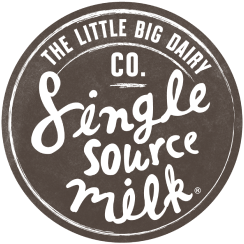Homogenisation is a process where milk is forced through a machine under high pressure. The purpose of doing this is to break up the fat particles so they are dispersed throughout the milk and don't appear as separate cream at the top of the milk. The effect, therefore, is mainly cosmetic and adds no real benefit.
Homogenisation is undertaken because there is a perception that many people prefer white milk to a cream colour. However, many are questioning the benefit of this. Moreover, some even prefer to consume raw milk that has not been processed in any way. For those seeking a middle ground, non-homogenised milk offers a less processed option while maintaining safety standards.

Why People Prefer Raw Milk
Before milk can be homogenised, it must be pasteurised. This process heats milk to 72°C for fifteen seconds, as is more common in Australia, or to 63°C for thirty minutes. The purpose of this is to kill bacteria and so increase the milk's shelf life as well as making it safer to consume. A more extreme process is ultra-high temperature (UHT) treatment, which heats the milk to 135-150°C for a few seconds in order to extend the shelf life of unopened milk to six months or more.
Raw milk is not treated in any way and has no additives. Advocates claim that, because of this, it is a more natural product that contains more minerals, vitamins, fatty acids, amino acids, and antimicrobials than pasteurised milk. They also claim it is better for those who have allergies, asthma, lactose intolerance, and auto-immune conditions.
Many health-conscious consumers believe pasteurisation reduces many of the health benefits that milk provides and removes many of its nutriments. They also think that some of the harmful bacteria that pasteurisation destroys are no longer an issue due to advances in healthcare.
Is Raw Milk Really a Sensible Option?
Studies have shown that pasteurisation causes a minimal loss of water-soluble vitamins that are present in milk. Fat-soluble vitamins also decrease very little while phosphorus and calcium are heat-stable and provide 23% and 20% respectively of the recommend daily intake in a cup of milk.
Pasteurisation has little effect on the presence of fatty acids, and the main protein, casein, is heat-stable. The secondary protein, whey, has more heat damage, but there is little impact on its digestibility or nutritional composition.
Research has shown that raw milk can reduce the risk of fever and respiratory infections in children and that some had a lower rate of asthma and hay fever. However, there is no evidence that it is better for those with lactose intolerance and lactose-free milk is a better option. The activity of antimicrobials is reduced when milk is refrigerated and that doesn't alter if it is pasteurised or raw.
There are, however, known risks when drinking raw milk, which can contain significantly higher levels of bacteria than pasteurised milk. These can cause the same symptoms as any food-borne illness, such as diarrhoea, vomiting, nausea, and abdominal pain. Most at risk are young children, pregnant women, and older adults.
In the end, it comes down to personal choice, and people are free to drink raw milk rather than pasteurised milk, provided they understand the risks. For those seeking quality milk with minimal processing but maintained safety standards, The Little Big Dairy Co offers single-source milk options that balance natural goodness with responsible dairy practices.






